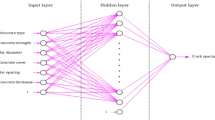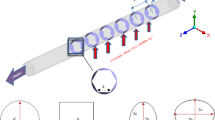Abstract
Warm rotary draw bending provides a feasible method to form the large-diameter thin-walled (LDTW) TC4 bent tubes, which are widely used in the pneumatic system of aircrafts. An accurate prediction of flow behavior of TC4 tubes considering the couple effects of temperature, strain rate and strain is critical for understanding the deformation behavior of metals and optimizing the processing parameters in warm rotary draw bending of TC4 tubes. In this study, isothermal compression tests of TC4 tube alloy were performed from 573 to 873 K with an interval of 100 K and strain rates of 0.001, 0.010 and 0.100 s−1. The prediction of flow behavior was done using two constitutive models, namely modified Arrhenius model and artificial neural network (ANN) model. The predictions of these constitutive models were compared using statistical measures like correlation coefficient (R), average absolute relative error (AARE) and its variation with the deformation parameters (temperature, strain rate and strain). Analysis of statistical measures reveals that the two models show high predicted accuracy in terms of R and AARE. Comparatively speaking, the ANN model presents higher predicted accuracy than the modified Arrhenius model. In addition, the predicted accuracy of ANN model presents high stability at the whole deformation parameter ranges, whereas the predictability of the modified Arrhenius model has some fluctuation at different deformation conditions. It presents higher predicted accuracy at temperatures of 573–773 K, strain rates of 0.010–0.100 s−1 and strain of 0.04–0.32, while low accuracy at temperature of 873 K, strain rates of 0.001 s−1 and strain of 0.36–0.48. Thus, the application of modified Arrhenius model is limited by its relatively low predicted accuracy at some deformation conditions, while the ANN model presents very high predicted accuracy at all deformation conditions, which can be used to study the compression behavior of TC4 tube at the temperature range of 573–873 K and the strain rate of 0.001–0.100 s−1. It can provide guideline for the design of processing parameters in warm rotary draw bending of LDTW TC4 tubes.










Similar content being viewed by others
References
Yang H, Li H, Zhang ZY, Zhan M, Liu J, Li GJ. Advances and trends on tube bending forming technologies. Chinese J Aeronaut. 2012;25(1):1.
Li H, Yang H, Liu K. Towards an integrated robust and loop tooling design for tube bending. Int J Adv Manuf Technol. 2013;9–12:1303.
Zhang ZY, Yang H, Li H, Ren N, Wang D. Quasi-static tensile behavior and constitutive modeling of large diameter thin-walled commercial pure titanium tube. Mater Sci Eng A. 2013;569:96.
Zhang ZY, Yang H, Li H, Tao ZJ, Wang D. Thermo-mechanical coupled 3D-FE modeling of heat rotary draw bending for large-diameter thin-walled CP-Ti tube. Int J Adv Manuf Tech. 2014;72:1187.
Zhang ZY, Yang H, Li H, Ren N, Tian YL. Bending behaviors of large diameter thin-walled CP-Ti tube in rotary draw bending. Prog Nat Sci Mater Int. 2011;21(5):401.
Mandal S, Rakesh V, Sivaprasad PV, Venugopal S, Kasiviswanathan KV. Constitutive equations to predict high temperature flow stress in a Ti-modified austenitic stainless steel. Mater Sci Eng A. 2009;500:114.
Yin F, Hua L, Mao HJ, Han XH. Constitutive modeling for flow behavior of GCr15 steel under hot compression experiments. Mater Des. 2013;43:393.
Luo J, Li MQ, Li XL, Shi YP. Constitutive model for high temperature deformation of titanium alloys using internal state variables. Mec Mater. 2010;42(2):157.
Kotkunde Nitin, Deole Aditya D. Amit Kumar Gupta, Swadesh Kumar Singh. Comparative study of constitutive modeling for Ti–6Al–4V alloy at low strain rates and elevated temperatures. Mater Des. 2014;55:999.
Sun SD, Zong YY, Shan DB, Guo B. Hot deformation behavior and microstructure evolution of TC4 titanium alloy. Trans Non Met Soc China. 2010;11(20):2181.
Kotkunde N, Krishnamurthy HN, Puranik P, Gupta AK, Singh SK. Microstructure study and constitutive modeling of Ti–6Al–4V alloy at elevated temperatures. Mater Des. 2014;54:96.
Zhan M, Du HF, Liu J, Ren N. A method for establishing the plastic constitutive relationship of the weld bead and heat-affected zone of welded tubes based on the rule of mixtures and microhardness test. Mater Sci Eng A. 2010;527:2864.
Lin YC, Chen XM. A critical review of experimental results and constitutive descriptions for metals and alloys in hot working. Mater Des. 2001;32:1733.
Jonas JJ, Sellars CM, Mc Tegart WJ. Strength and structure under hot-working conditions. Int Met Rev. 1969;14:1.
Samantaray D, Phaniraj C, Mandal S, Bhaduri AK. Strain dependent rate equation to predict elevated temperature flow behavior of modified 9Cr–1Mo (P91) steel. Mater Sci Eng A. 2011;528:1071.
Peng WW, Zeng WD, Wang QJ, Yu HQ. Comparative study on constitutive relationship of as-cast Ti60 titanium alloy during hot deformation based on Arrhenius-type and artificial neural network models. Mater Des. 2013;51:95.
Lin YC, Chen MS, Zhong J. Prediction of 42CrMo steel flow stress at high temperature and strain rate. Mech Res Commun. 2008;35(3):142.
Marandi A, Zarei-Hanzaki A, Haghdadi N, Eskandari M. The prediction of hot deformation behavior in Fe–21Mn–2.5Si–1.5Al transformation-twinning induced plasticity steel. Mater Sci Eng A. 2012;554:72.
Ji GL, Li FG, Li QH, Li HQ, Li Z. A comparative study on Arrhenius-type constitutive model and artificial neural network model to predict high temperature deformation behaviour in Aermet100 steel. Mater Sci Eng A. 2011;528:4774.
Lin YC, Xia YC, Chen XM, Chen MS. Constitutive descriptions for hot compressed 2124-T851 aluminum alloy over a wide range of temperature and strain rate. Comput Mater Sci. 2010;50(1):227.
Samantaray D, Mandal S, Bhaduri AK. Constitutive analysis to predict high temperature flow stress in modified 9Cr–1Mo (P91) steel. Mater Des. 2010;31:981.
Rezaei Ashtiania HR, Parsab MH, Bisadi H. Constitutive equations for elevated temperature flow behavior of commercial purity aluminum. Mater Sci Eng A. 2012;545:61.
Lin YC, Chen XM. A combined Johnson-Cook and Zerilli-Armstrong model for hot compressed typical high-strength alloy steel. Comput Mater Sci. 2010;49(3):628.
He A, Xie GL, Zhang HL, Wang XT. A modified Zerilli-Armstrong constitutive model to predict hot deformation behavior of 20CrMo alloy steel. Mater Des. 2014;56:122.
Momeni A, Dehghani K, Ebrahimi GR, Keshmiri H. Modeling the flow curve characteristics of 410 martensitic stainless steel under hot working condition. Metall Mater Trans A. 2010;41(11):2898.
Wang L, Liu F, Zuo Q, Chen CF. Prediction of flow stress for N08028 alloy under hot working conditions. Mater Des. 2013;47:737.
Dipti S, Sumantra M, Bhaduri AK. A comparative study on Johnson Cook, modified Zerilli-Armstrong and Arrhenius-type constitutive models to predict elevated temperature flow behaviour in modified 9Cr–1Mo steel. Comput Mater Sci. 2009;47(2):568.
Dipti S, Alpesh P, Utpal B, Albert SK, Bhaduri AK. Constitutive flow behavior of IFAC-1 austenitic stainless steel depicting strain saturation over a wide range of strain rates and temperatures. Mater Des. 2014;56:565.
Rusinek A, Rodríguez-Martínez JA, Arias A. A thermo-viscoplastic constitutive model for FCC metals with application to OFHC copper. Int J Mech Sci. 2010;52(2):120.
Mandal S, Sivaprasad PV, Venugopal S. Capability of a feed-forward artificial neural network to predict the constitutive flow behavior of as cast 304 stainless steel under hot deformation. Trans ASME J Eng Mater Technol. 2007;129:242.
Sun Y, Zeng WD, Zhao YQ, Zhang XM, Shu Y, Zhou YG. Modeling constitutive relationship of Ti40 alloy using artificial neural network. Mater Des. 2011;32:1537.
Han YF, Zeng WD, Zhao YQ, Zhang XM, Sun Y, Ma X. Modeling of constitutive relationship of Ti–25V–15Cr–0.2Si alloy during hot deformation process by fuzzy-neural network. Mater Des. 2010;31:4380.
Li HY, Wei DD, Li YH, Wang XF. Application of artificial neural network and constitutive equations to describe the hot compressive behavior of 28CrMnMoV steel. Mater Des. 2012;35:557.
Lin YC, Zhang J, Zhong J. Application of neural networks to predict the elevated temperature flow behavior of a low alloy steel. Comp Mater Sci. 2008;43(4):752.
Liu J, Cui ZS, Li CX. Modelling of flow stress characterizing dynamic recrystallization for magnesium alloy AZ31B. Comp Mater Sci. 2008;41(3):375.
Ma X, Zeng WD, Sun Y, Wang KX, Lai YJ, Zhou YG. Modeling constitutive relationship of Ti17 titanium alloy with lamellar starting microstructure. Mater Sci Eng A. 2012;538:182.
Acknowledgments
This work was financially supported by the National Natural Science Foundation of China (Nos. 51275415 and 50905144), the Natural Science Basic Research Plan in Shanxi Province (No. 2011JQ6004) and the Program of the Ministry of Education of China for Introducing Talents of Discipline to Universities (No. B08040).
Author information
Authors and Affiliations
Corresponding author
Rights and permissions
About this article
Cite this article
Tao, ZJ., Yang, H., Li, H. et al. Constitutive modeling of compression behavior of TC4 tube based on modified Arrhenius and artificial neural network models. Rare Met. 35, 162–171 (2016). https://doi.org/10.1007/s12598-015-0620-4
Received:
Revised:
Accepted:
Published:
Issue Date:
DOI: https://doi.org/10.1007/s12598-015-0620-4




